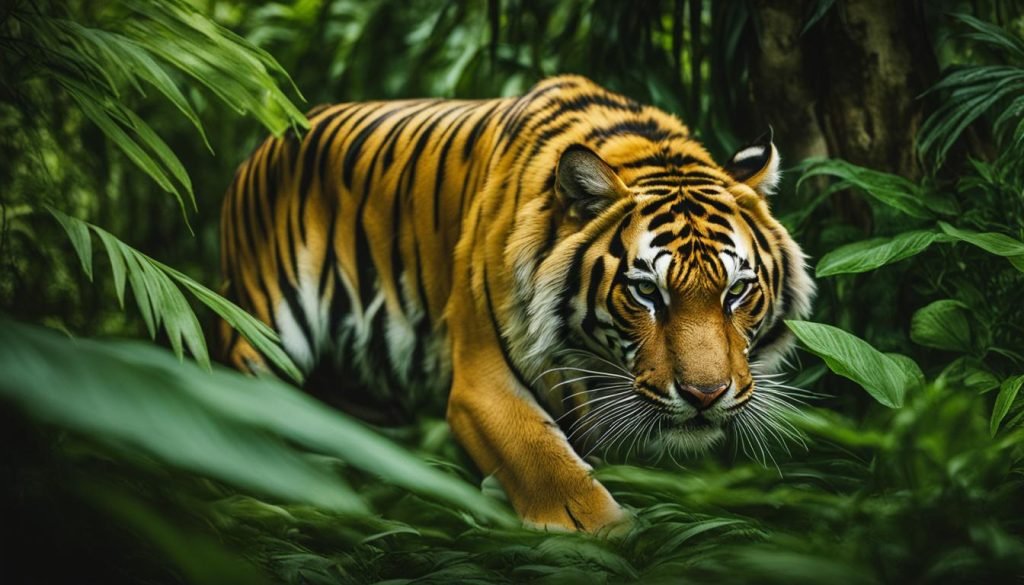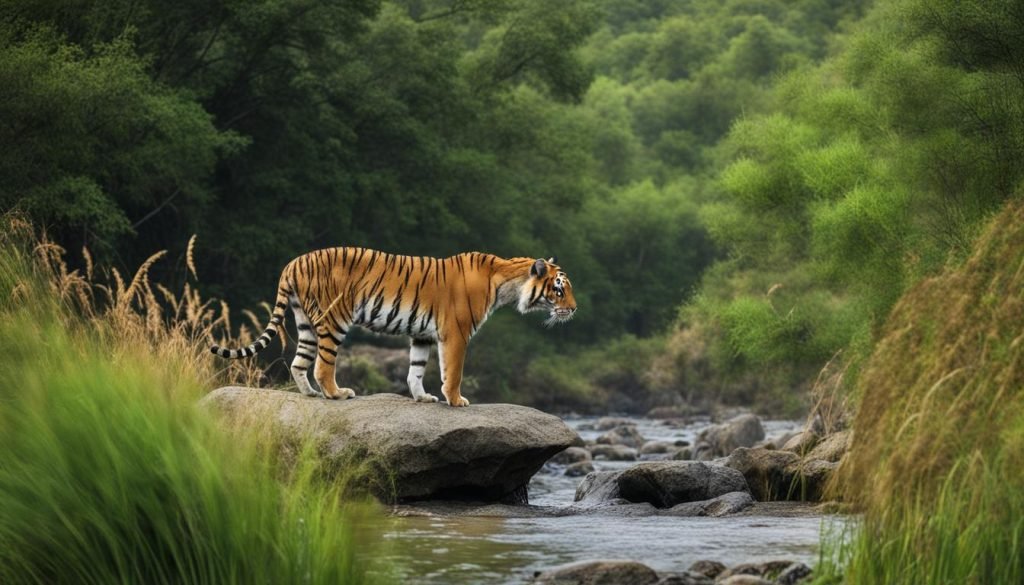What Do Tigers Eat? – A Comprehensive Guide
Greetings fellow animal lovers!
As a copywriting journalist, I am excited to delve into the fascinating world of tigers and their dietary habits.
Have you ever wondered, “What do tigers eat?” Well, you’ve come to the right place!
In this comprehensive guide, we will explore the intricacies of what tigers eat, their feeding habits, and the natural food sources that sustain these magnificent creatures.
Tigers are apex predators and are known for their carnivorous diet. Their strong, agile bodies and sharp teeth make them well-equipped for hunting and consuming prey animals. However, their food preferences and hunting behavior can vary depending on their habitat and availability of prey.
In this article, we will cover everything from tigers’ natural food sources in the wild to their diet in captivity.
We’ll also discuss how human interaction and conservation efforts impact their feeding habits. So, buckle up and join me as we embark on this exciting journey through the captivating world of the tiger diet!
Key Takeaways
- Tigers are apex predators with a carnivorous diet
- Their food preferences and hunting behavior can vary depending on their habitat and prey availability
- In this guide, we’ll explore tigers’ natural food sources, diet in captivity, and human-tiger conflict due to food scarcity
- Conservation efforts are vital for the survival of tigers and their dietary habits
- Understanding the intricacies of tiger diets helps us appreciate their importance in the ecosystem
Tiger Quiz
How well do you know tigers? Test your knowledge below!

Understanding the Carnivorous Nature of Tigers

Welcome back, folks! As we dive deeper into the fascinating world of tigers, let’s explore why they’re considered carnivorous animals.
Tigers are part of the cat family and have sharp, pointed teeth and strong, powerful jaws that are perfect for hunting and consuming meat. Their agile bodies are built for chasing down prey and quickly pouncing on them.
As carnivorous animals, tigers rely on a diet that primarily consists of meat. From the mighty Bengal tigers that hunt deer and wild boars to the smaller Sumatran tigers that prey on rabbits and birds, their natural food preferences and hunting behavior vary depending on their habitat and availability of prey.
The Carnivorous Diet of Tigers
The term “carnivorous” implies that tigers feed exclusively on meat. However, their diet can also include parts of the animal that are not meat, such as bones and organs. Some might consider this a form of scavenging, but tigers are carnivores through and through.
Fun fact: A full-grown tiger can consume up to 40 pounds (18 kilograms) of meat in a single meal!
Tigers are skilled hunters and use their stealth, speed, and strength to capture their prey. They often hunt alone and rely on their senses, including their exceptional vision and hearing, to locate their food.
Now that we’ve explored the carnivorous nature of tigers, let’s take a closer look at their food preferences and hunting behavior in the next section.
Tiger Food Preferences and Hunting Behavior

As opportunistic hunters, tigers have a diverse diet that can vary depending on their habitat and availability. They are known to be versatile predators and can hunt both large and small prey animals.
Their food preferences include:
- Large ungulates such as deer and wild boar
- Smaller prey like rabbits and birds
- Occasionally fish, depending on the ecosystem they reside in
Their hunting behavior is swift and efficient, relying on their agility and sharp teeth. They are known for stalking their prey and approaching it from behind. Once they are within close range, they pounce and deliver a lethal bite to the neck or throat. In some cases, they suffocate their prey by clamping their jaws around the animal’s windpipe.
Tigers are also known to be patient hunters, often waiting in ambush for hours for their prey to pass by. This behavior is particularly evident when hunting larger prey like deer.
“Tigers are versatile predators and can hunt both large and small prey animals.”
Natural Food Sources for Tigers in the Wild

Tigers are highly adaptable carnivores that rely on a diverse range of natural habitats to find their food sources. Let’s explore the different ecosystems where tigers can find their meals.
| Habitat | Natural Prey |
|---|---|
| Tropical forests | Deer, wild boar, monkeys, birds, reptiles, fish |
| Grasslands | Buffalo, antelopes, zebras, wildebeest, warthogs |
| Savannahs | Gazelles, impalas, waterbucks, hares, birds |
These are just a few examples of the natural food sources that tigers can find in the wild. Their diet is not limited to these options, as they are opportunistic hunters who can adapt to changing environments and food availability.
In some cases, tigers have even been known to hunt domestic animals such as cattle and goats when natural prey is scarce. This can sometimes lead to conflicts with humans, as we’ll explore in a later section.
Typical Tiger Meals
As carnivores, tigers consume a range of prey animals to meet their nutritional needs. A typical meal for a tiger usually consists of one large prey animal, such as a deer or wild boar. However, their food preferences vary depending on their habitat and availability. Tigers have been known to eat smaller prey such as rabbits, birds, and even fish if they live near water bodies.
A full-grown tiger can consume up to 40 pounds (18 kilograms) of meat in a single sitting, which is equivalent to the weight of a small child. Their massive size and muscular bodies require a substantial amount of energy, and they need to eat approximately every 2-3 days to sustain themselves in the wild.
Interestingly, tigers are solitary hunters, meaning they prefer to hunt alone rather than in packs. This behavior requires them to undertake a lot of energy-intensive hunting, which makes it important for them to consume large meals.
| Prey | Quantity |
|---|---|
| Deer | 1 |
| Wild boar | 1 |
| Rabbit | 2-3 |
| Bird | 1-2 |
| Fish | 1-2 |
As shown in the table above, a single tiger can consume the equivalent of their body weight in one week, highlighting their massive appetite and need for a diverse diet.
“Tigers are well-adapted for hunting and consuming their prey. They have sharp teeth and strong jaws that can easily tear through flesh, making them one of the most fearsome predators in the wild.”
Overall, tigers have a diverse and impressive diet that is crucial to their survival in the wild. By consuming a range of prey animals, they ensure they receive all the necessary nutrients to maintain their health and vitality. The next time you think of tigers, remember their voracious appetite and the incredible strength it takes to hunt and survive in the wild.
Tiger Diet in Captivity

As majestic creatures, tigers require a balanced and nutritious diet to maintain their health and well-being. Captive tigers have specific dietary requirements that need to be met by their caretakers. The diet of captive tigers is carefully planned, taking into consideration their age, sex, weight, physical condition, and other health factors.
Did you know? A captive tiger’s diet may differ from that of a wild tiger due to the availability of resources and their activity levels.
The diet of captive tigers usually consists of commercially prepared meat, such as beef or horse, and may also include chicken or fish. Their meals are supplemented with vitamins and minerals to ensure they receive all the necessary nutrients.
A typical diet for a captive tiger may consist of:
| Meal | Food | Quantity |
|---|---|---|
| Breakfast | Beef | 5 lbs (2.27 kg) |
| Lunch | Chicken or Fish | 4 lbs (1.81 kg) |
| Dinner | Horse | 6 lbs (2.72 kg) |
It is essential to provide a balanced and varied diet for captive tigers to prevent digestive problems and ensure their overall well-being.
Tigers and the Food Chain
As apex predators, tigers play an essential role in maintaining the food chain’s balance in their respective habitats. Their hunting and feeding habits keep prey animal populations in check, preventing overgrazing and habitat destruction.
Tigers prey on a variety of animals, including deer, wild boar, and buffalo. Their diet also consists of smaller mammals such as rabbits, hares, and rodents, as well as birds and fish. By consuming a range of prey animals, tigers help maintain a diverse ecosystem.
When there is a scarcity of natural prey, human-tiger conflicts can arise as tigers may turn to livestock for food. These conflicts can have devastating effects on local communities and threaten tiger populations. Efforts are being made to mitigate these conflicts by providing alternative livelihoods for communities and protecting tiger habitats.
“The presence of tigers in an ecosystem indicates a healthy and balanced environment.”
Conservation initiatives have helped in protecting tiger populations and their habitats. As tiger populations recover, the prey animals that sustain them also benefit from protection.
It’s essential to remember that tigers are part of a delicate ecosystem, and their presence indicates a healthy and balanced environment. By preserving tiger habitats and protecting prey animals, we can ensure that tigers continue to play their important role in the food chain.
Human-Tiger Conflict Due to Food Scarcity
It’s no secret that tigers have a carnivorous diet, but what happens when their natural sources of food become scarce? Sadly, this is where human-tiger conflict can arise.
Tigers require a lot of food to sustain their energy levels, and as their natural habitats shrink and prey populations decline due to human activities such as deforestation and poaching, tigers are forced to seek out alternative food sources.
This often means venturing into human settlements and preying on domestic animals such as cattle or even attacking humans in extreme cases. As a result, tigers are viewed as a threat by local communities, leading to retaliatory killings.
Efforts are being made to mitigate these conflicts and address the root causes of food scarcity. For example, in some areas, conservationists are working with local communities to establish sustainable agricultural practices that minimize human-tiger conflict.
Another approach is the creation of protected areas where tiger populations can thrive and natural food sources are preserved. These initiatives not only benefit tigers but also support the livelihoods of local communities and promote biodiversity conservation.
However, it’s important to acknowledge that there is no one-size-fits-all solution and that human-tiger conflict continues to be a complex issue that requires a multifaceted approach. By addressing food scarcity, we can help prevent these conflicts and ensure a sustainable future for tigers and their habitats.
Tiger Conservation Efforts and Impact on Diet
As we’ve explored in previous sections, the feeding habits of tigers are closely tied to their natural habitats. With the rising threat of habitat loss and poaching, it’s more critical than ever to protect tiger populations and their food sources. Conservation efforts have helped safeguard vital habitats and prey populations, which has had a positive impact on the diet of tigers.
One example of successful conservation work is the increase in the number of tigers in India. The country has implemented an ambitious project called “Project Tiger,” aimed at protecting tiger habitats and maintaining prey populations. As a result, the number of tigers in India has almost doubled in recent years. This increase is a clear indication of how effective conservation measures can help tigers thrive in the wild.
Another vital aspect of tiger conservation is ensuring that captive tigers receive a proper diet. These tigers rely on their caretakers to provide them with all the nutrients they need. A balanced diet is crucial for their overall health and well-being. By understanding the natural feeding habits of tigers and tailoring their diets, caretakers can help maintain the health of captive tigers.
However, conservation efforts alone are not enough to ensure the survival of tigers. Human-tiger conflict, habitat loss, and poaching remain significant threats to tiger populations. We must continue to take action to protect these magnificent creatures and their habitats to ensure their long-term survival. By doing so, we can also help preserve the delicate balance of the ecosystems they inhabit.
Tigers and Their Interaction with Humans: How It Affects Their Diet
As we’ve explored in previous sections, tigers are carnivorous animals with a diverse diet that varies depending on the availability of prey animals in their natural habitats. However, their feeding behavior can be disrupted by human activities that affect their natural habitats and prey populations. In this section, we’ll examine how human interaction affects the diet and hunting behavior of tigers.
Human Impact on Tiger Diet
Habitat loss and fragmentation are significant challenges faced by tigers. As human populations expand and encroach on tiger territories, these majestic creatures are forced to adapt to changing circumstances. Human activities like deforestation, mining, and construction often destroy or fragment their natural habitats, making it difficult for tigers to find prey animals. This can lead to a scarcity of natural prey for tigers, forcing them to hunt domesticated livestock like cattle, goats, and sheep.
“Human-tiger conflict often arises when there is a scarcity of natural prey for tigers.”
Human-tiger conflict can also arise when tigers hunt in proximity to human settlements. In this situation, tigers can turn to hunting humans, causing fatalities and leading to retaliatory killings of tigers. To mitigate this conflict, conservationists and local communities are working together to develop measures to reduce human-tiger conflict.
The Impact of Illegal Wildlife Trade on Tiger Diet
Illegal wildlife trade is another significant threat to tigers and their natural habitats. The demand for tiger parts and products in traditional medicine and folk remedies has led to poaching and illegal trade in tiger skins, bones, and other body parts. This has resulted in a decline in tiger populations and reduced their prey populations, further exacerbating the scarcity of prey animals in their habitats.
These illegal activities often impact the diets of tigers, as their prey populations decline alongside tiger populations. The loss of prey animals can force tigers to shift their diets, leading to more human-tiger conflict and the potential for harm to both tigers and humans.
The Importance of Responsible Tourism and Education
Responsible tourism and education are crucial components of tiger conservation efforts. By promoting sustainable tourism practices and educating visitors on the importance of conserving tiger populations and their habitats, we can reduce the impact of human activities on tiger diets. In addition, community-based conservation initiatives can help to develop alternative livelihoods for local communities that are not reliant on natural resources. This can reduce the pressure on tiger habitats and prey animals, helping to sustain their food sources.
As humans, we have a responsibility to preserve and protect the precious biodiversity of our planet. By understanding the impact of our actions on tiger diets and habitats, we can take steps to minimize our impact and ensure the survival of these magnificent creatures.
Tigers and Their Prey: A Coexistence Perspective

As carnivores, tigers have a diverse range of prey animals that are integral to their survival. From small animals like rabbits and birds to larger mammals like deer and wild boar, tigers have adapted to coexist alongside their prey in their natural habitats.
Tigers are solitary animals and use their highly developed senses to track down prey. They often stalk and ambush their prey, using their powerful jaws and sharp teeth to deliver a swift and fatal bite.
Despite being apex predators, tigers are not immune to the effects of habitat loss and human encroachment. In some areas, competition for resources can disrupt the delicate balance between tigers and their prey, leading to conflicts and endangering both species.
It’s important to note that prey species play a vital role in the ecosystem, and protecting them is crucial for maintaining a healthy balance. When prey populations decline, tigers may turn to alternative food sources such as livestock, leading to human-tiger conflicts.
To protect both tigers and their prey, conservation initiatives aim to preserve natural habitats and ensure sustainable land use practices. By providing suitable habitats for both tigers and their prey, we can help maintain the delicate balance that allows these magnificent creatures to thrive.
Conservation Efforts to Protect Prey Species
Conservation efforts have played an important role in protecting and preserving prey species that are essential to the survival of tigers. For example, the National Tiger Conservation Authority in India has launched several initiatives to protect deer populations, which are a primary source of food for tigers. These initiatives include habitat restoration, anti-poaching measures, and community-based conservation programs.
In addition, education and awareness campaigns can help promote coexistence between humans and wildlife. Teaching communities about the importance of preserving natural habitats and protecting prey species can reduce the likelihood of human-tiger conflicts.
The Future of Tigers and Their Prey
As we continue to face the challenges of habitat loss, climate change, and human-wildlife conflicts, it’s more important than ever to work towards a sustainable future for tigers and their prey. By protecting natural habitats and preserving prey species, we can help ensure the survival of these magnificent creatures for generations to come.
The Intricate Balance of Tiger Diets
As I’ve explored in this comprehensive guide, the diet of tigers is a crucial component of their overall well-being. Understanding their natural food preferences and hunting behavior helps us appreciate their importance in the ecosystem. But maintaining a healthy diet for tigers is not always easy, especially when they are in captivity.
The Importance of Tiger Diet in Captivity
When tigers are in captivity, their diet needs to be carefully planned to ensure they receive all the necessary nutrients. A balanced diet can help prevent health issues, ensure proper growth, and even extend their lifespan. As carnivores, tigers require a diet that is high in protein and fat, with relatively low levels of carbohydrates.
Challenges of Providing a Balanced Diet
However, providing a balanced diet for tigers can be a challenge. For one, it can be difficult to replicate the variety of food sources that they would naturally have access to in the wild. In addition, it can be expensive to source high-quality meat, which is often required to meet their nutritional needs. Some zoos and organizations have resorted to feeding tigers ground meat instead of whole carcasses to save costs, which can lead to nutritional deficiencies.
Tiger Food Preferences and the Ecosystem
It’s not just captivity that poses challenges for tiger diets. Human activities such as habitat loss and illegal wildlife trade can also disrupt their natural food preferences and hunting behavior. As apex predators, tigers play a vital role in the ecosystem by controlling the population of prey animals. Therefore, preserving natural habitats and protecting prey species is crucial for the long-term survival of these magnificent creatures.
In conclusion, the diet of tigers is a delicate balance that is vital for their well-being and the ecosystem as a whole. Whether in the wild or captivity, we must continue to educate ourselves and take action to ensure a sustainable future for these majestic cats.
More About Tigers
- How Do Tigers Mate? – Reproduction Explained
- How Long Do Tigers Live? Exploring Lifespans
- 15 Facts About Tigers That Will Surprise You
- Tiger Quiz: How Well Do You Know Tigers?
Frequently Asked Questions
What do tigers eat?
Tigers primarily eat meat and are known to consume a variety of prey animals, including deer, wild boar, rabbits, birds, and even fish in some cases.
Are tigers carnivorous?
Yes, tigers belong to the carnivorous family and have a diet that consists mainly of meat.
How much do tigers eat in one meal?
A full-grown tiger can consume up to 40 pounds (18 kilograms) of meat in a single meal.
What do tigers eat in captivity?
Tigers in captivity have carefully planned diets to ensure they receive all the necessary nutrients. Their diet often consists of commercially prepared meat and supplements.
Do tigers play a role in the food chain?
Yes, tigers are apex predators and play a vital role in the ecosystem by hunting and controlling the population of prey animals.
What causes human-tiger conflict?
Human-tiger conflict can arise when natural prey is scarce for tigers, leading to conflicts over resources and territory.
How do conservation efforts impact the diet of tigers?
Conservation initiatives help protect tiger populations and their habitats, ensuring a stable food source for tigers in the long term.
How do human activities affect the tiger diet?
Human activities such as habitat loss and illegal wildlife trade can disrupt the natural hunting behavior and diet of tigers.
How do tigers coexist with their prey animals?
Tigers and their prey have evolved to coexist in their habitats, each adapting to survive alongside the other.
Why is the tiger diet important for their well-being?
The diet of tigers is crucial for their overall well-being and plays a significant role in their ecological importance as apex predators.







